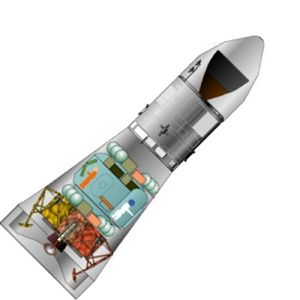
Home - Search - Browse - Alphabetic Index: 0- 1- 2- 3- 4- 5- 6- 7- 8- 9
A- B- C- D- E- F- G- H- I- J- K- L- M- N- O- P- Q- R- S- T- U- V- W- X- Y- Z
Apollo LASS
AKA: LM Adapter Surface Station. Status: Cancelled 1968. Gross mass: 7,700 kg (16,900 lb).
In comparison to the LM Shelter concept, this provided a lunar mini-base of superior capacity and capability. The SM was used for lunar orbit insertion and the first portion of descent to the lunar surface. The LM descent stage was used for final touchdown.
The SLA "mini-base" carried consumables for 192 man-days on the lunar surface and 5,090 kg cargo, amounting to a total payload weight of 7,700 kg. This meant that a crew of two astronauts could stay for 96 days. The SLA included a Lunar Roving Vehicle (LRV) and a Lunar Flying Unit (LFU) for the astronauts. Its cargo included 2,700 kg of mobility fuel for the LRV and LFU, plus 1,800 kg of scientific equipment.
The SLA mini-base would be delivered first by an unmanned shelter-logistics launch vehicle, followed by a personnel carrier launch which delivered two astronauts in an LM Taxi for the mini-base. Since it would not be practical to leave one astronaut in the CSM circling the moon for 100 days, the third astronaut flew the CSM back to Earth. Three months later, a third mission would be launched to return the lunar base crew to Earth.
In order to avoid the costly third launch, a small lunar orbiting base could be provided offering sufficient capacity for the astronauts in orbit to be active during their long stay-time in orbit. For this purpose, the SLA was extended by a cylindrical section to provide enough volume to house the Lunar Orbit Base (LOB) and the Lunar Surface Base (LSB). The resulting LASSO configuration could be delivered by a standard Saturn V. Delivery was unmanned, followed by a second launch carrying a CSM, modified to house 4 astronauts and an LM Taxi with a capacity for 2 astronauts. The LSB had a quiescent capability of 100 days, and the LM Taxi 60 days.
First, the unmanned SLA LOB/LSB was delivered into lunar orbit, followed by the personnel transport launch. The two lunar surface astronauts occupied the LM Taxi, while the CSM with the two lunar orbit astronauts was transferred to the SLA LOB/LSB complex. There they controlled the unmanned descent of the LSB, using the first SM and the LM descent stage. Preceding or following the LSB landing, the surface astronauts descend in the LM Taxi.
The cargo delivered to the surface in the LSB, along with the consumables, was 3,100 kg for 2 men and 60 days, corresponding to 25.7 kg/man-day.
Family: Lunar Habitats, Moon. Country: USA. Spacecraft: ALSS Lunar Base. Launch Vehicles: Saturn V.
Back to top of page
Home - Search - Browse - Alphabetic Index: 0- 1- 2- 3- 4- 5- 6- 7- 8- 9
A- B- C- D- E- F- G- H- I- J- K- L- M- N- O- P- Q- R- S- T- U- V- W- X- Y- Z
© 1997-2019 Mark Wade - Contact
© / Conditions for Use
